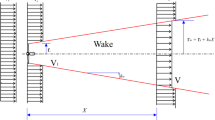Abstract
In consideration of the resource wasted by unreasonable layout scheme of tidal current turbines, which would influence the ratio of cost and power output, particle swarm optimization algorithm is introduced and improved in the paper. In order to solve the problem of optimal array of tidal turbines, the discrete particle swarm optimization (DPSO) algorithm has been performed by re-defining the updating strategies of particles’ velocity and position. This paper analyzes the optimization problem of micrositing of tidal current turbines by adjusting each turbine’s position, where the maximum value of total electric power is obtained at the maximum speed in the flood tide and ebb tide. Firstly, the best installed turbine number is generated by maximizing the output energy in the given tidal farm by the Farm/Flux and empirical method. Secondly, considering the wake effect, the reasonable distance between turbines, and the tidal velocities influencing factors in the tidal farm, Jensen wake model and elliptic distribution model are selected for the turbines’ total generating capacity calculation at the maximum speed in the flood tide and ebb tide. Finally, the total generating capacity, regarded as objective function, is calculated in the final simulation, thus the DPSO could guide the individuals to the feasible area and optimal position. The results have been concluded that the optimization algorithm, which increased 6.19% more recourse output than experience method, can be thought as a good tool for engineering design of tidal energy demonstration.
Similar content being viewed by others
References
Ammara, I., Leclerc, C. and Masson, C., 2002. A viscous three-dimensional differential/actuator-disk method for the aerodynamic analysis of wind farms, Journal of Solar Energy Engineering, 124(4), 345–356.
Bahaj, A.S., 2011. Generating electricity from the oceans, Renewable and Sustainable Energy Reviews, 15(7), 3399–3416.
Funke, S.W., Farrell, P.E. and Piggott, M.D., 2014. Tidal turbine array optimisation using the adjoint approach, Renewable Energy, 63, 658–673.
Hou, F., Yu, H.M., Bao, X.W. and Wu, H., 2014. Analysis of tidal current energy in Zhoushan sea area based on high resolution numerical modeling, Acta Energiae Solaris Sinica, 35(1), 125–133. (in Chinese)
Jensen, N.O., 1983. A Note on Wind Generator Interaction, Risø National Laboratory, Roskilde, Denmark.
Kennedy, J., 2010. Particle swarm optimization, in: Encyclopedia of Machine Learning, Sammut, C. and Webb, G.I. (eds.), Springer, Boston, MA, pp. 760–766.
Kiranoudis, C.T. and Maroulis, Z.B., 1997. Effective short-cut modelling of wind park efficiency, Renewable Energy, 11(4), 439–457.
Lee, S.H., Lee, S.H., Jang, K., Lee, J. and Hur, N., 2010. A numerical study for the optimal arrangement of ocean current turbine generators in the ocean current power parks, Current Applied Physics, 10(S2), S137–S141.
Legrand, C., 2009. Assessment of Tidal Energy Resource: Marine Renewable Energy Guides, European Marine Energy Centre Ltd., London.
Lin, T.Y., Yeh, J.T. and Kuo, W.S., 2017. Using particle swarm optimization algorithm to search for a power ascension path of boiling water reactors, Annals of Nuclear Energy, 102, 37–46.
Macleod, A., Barnes, S., Rados, K.G. and Bryden, I., 2002. Wake effects in tidal current turbine farms, Proceedings of Conference on Marine Renewable Energy (MAREC 2002), The Institute of Marine Engineering, Science and Technology, Newcastle, UK.
Myers, L. and Bahaj, A.S., 2005. Simulated electrical power potential harnessed by marine current turbine arrays in the Alderney Race, Renewable Energy, 30(11), 1713–1731.
Wu, Y.N., Wu, H. and Feng, Z., 2017. Assessment of tidal current energy resource at Putuo Mountain-Hulu Island waterway, Renewable Energy Resources, 35(10), 1566–1573. (in Chinese)
Xia, X.W., Xie, C.W., Wei, B., Hu, Z.B., Wang, B.J. and Jin, C., 2017. Particle swarm optimization using multi-level adaptation and purposeful detection operators, Information Sciences, 385–386, 174–195.
Author information
Authors and Affiliations
Corresponding author
Additional information
Foundation item: The work was financially supported by the Marine Renewable Energy Funding Project (Grant Nos. GHME2017ZC01 and GHME2016ZC04), the National Natural Science Foundation of China (Grant Nos. 5171101175 and 51679125), Tianjin Municipal Natural Science Foundation (Grant No. 16JCYBJC20600), and Technology Innovation Fund of National Ocean Technology Center (Grant No. F2180Z002).
Rights and permissions
About this article
Cite this article
Wu, Gw., Wu, H., Wang, Xy. et al. Tidal Turbine Array Optimization Based on the Discrete Particle Swarm Algorithm. China Ocean Eng 32, 358–364 (2018). https://doi.org/10.1007/s13344-018-0037-6
Received:
Revised:
Accepted:
Published:
Issue Date:
DOI: https://doi.org/10.1007/s13344-018-0037-6




